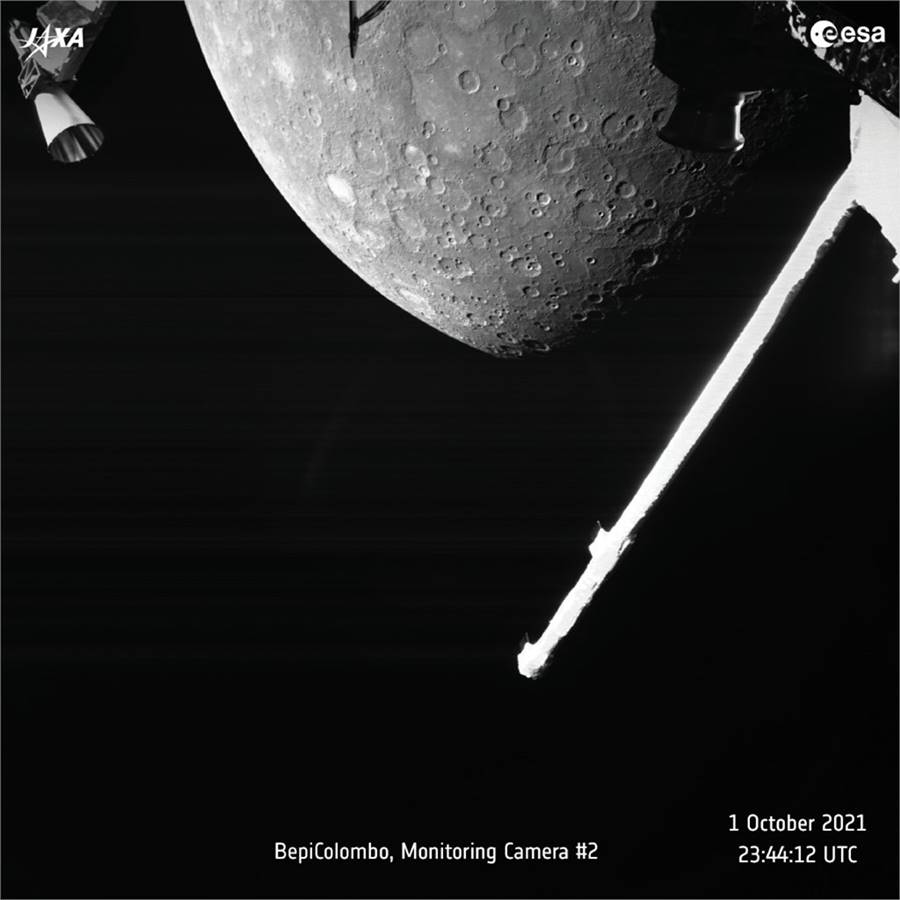A joint European-Japanese spacecraft has sent back its first images of Mercury, the nearest planet to the Sun.
The European Space Agency said the BepiColombo mission made the first of six flybys of Mercury at 11:34pm GMT on Friday, using the planet’s gravity to slow the spacecraft down.
After swooping past Mercury at altitudes of less than 200 kilometres (125 miles), the spacecraft took a low-resolution black-and-white photo with one of its monitoring cameras before zipping off again.
Hello, Mercury!
This splendid view of part of Mercury’s northern hemisphere was captured by @ESA_MTM about 10 mins after #MercuryFlyby close approach, from a distance of 2420km. https://t.co/jjGKrsQXDH#ExploreFarther pic.twitter.com/EMhMJ5tKiN
— Bepi (@ESA_Bepi) October 2, 2021
The ESA said the captured image shows the Northern Hemisphere and Mercury’s characteristic pock-marked features, among them the 166-km-wide (103-mile-wide) Lermontov crater.
“The flyby was flawless from the spacecraft point of view, and it’s incredible to finally see our target planet,” said Elsa Montagnon, spacecraft operations manager for the mission.
The joint mission by ESA and the Japan Aerospace Exploration Agency was launched in 2018, flying once past Earth and twice past Venus on its journey to the solar system’s smallest planet.
ESA said the BepiColombo mission will study all aspects of Mercury from its core to surface processes, magnetic field and exosphere, “to better understand the origin and evolution of a planet close to its parent star”.
Tomorrow!
Here is the trailer for our 1st Mercury swing-by.Epic and cool!#BepiColombo #MercuryFlyby #Mio https://t.co/r1gGpeY2Nc
— みお (MIO) (@JAXA_MMO) October 1, 2021
The mission aims to deliver two probes into Mercury’s orbit by the end of 2025.
The spacecraft could not be sent directly to the planet, as the Sun’s pull is so strong that a huge braking manoeuvre would be needed to place the satellite successfully, requiring too much fuel for a ship of this size.
The gravity exerted by the Earth and Venus – known as gravitational assist – allows it to slow down ‘naturally’ during its journey.
Five further flybys are needed before BepiColombo is sufficiently slowed down to release ESA’s Mercury Planetary Orbiter and JAXA’s Mercury Magnetospheric Orbiter.
Farouk El Baz, a space scientist at Boston University, called the successful flyby an “extraordinary moment”.
“It’s wonderful because of the fact that we used the gravitational pull of Mercury to put the spacecraft close enough so that we can see the pictures,” he told Al Jazeera.
“We have not been there for a long time and only two missions visited Mercury before, so we are expecting a great deal of information. We know that there is probably some leftover water, tiny amounts in the polar regions, in areas that never see the sun. But we are not sure about that,” he said.
“We hope this mission will give us a look at whether or not there is a little bit of water in the polar regions, where they never see the sun, where it is cold, freezingly cold. But the planet moves around the sun very fast. It rotates around the sun in 88 days. So it is very different to other planets. So we need to know what it is made of, how did it develop, whether it has a gravitational field or not.”
The mission is named after Italian scientist Giuseppe “Bepi” Colombo, who is credited with helping develop the gravity assist manoeuvre that NASA’s Mariner 10 first used when it flew to Mercury in 1974.
_____________________________________________________________________________
FOLLOW INDEPENDENT PRESS:
TWITTER (CLICK HERE)
https://twitter.com/IpIndependent
FACEBOOK (CLICK HERE)
https://web.facebook.com/ipindependent
Think your friends would be interested? Share this story!





